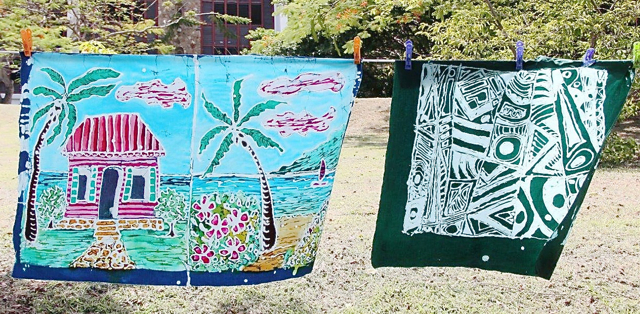
Opening Friday at the V.I. Council on the Arts in downtown Charlotte Amalie, the show will run through Jan. 9.
Dr. Caryl Johnson, program supervisor at the Cooperative Extension Service at the University of the Virgin Islands, introduced the course and teaches it once a week on the St. Thomas campus. She’s hoping it will be the genesis of a cottage industry, with batiks selling both to residents and to tourists.
Not to be confused with tie-dying, batik is an art form that involves applying dye-resistant wax to fabric to create intricate patterns. It’s associated especially with Java and throughout Indonesia, with fine examples dating to at least the 12th century, but the technique probably is considerably older. Some sources note that Egyptians were using batik-style burial clothes six thousand years ago.
Johnson is a newcomer to the world of batik herself. She took a course from artist Annalisa Jensen on St. John a few years ago and said she got so excited about the technique she wanted to share it with her own students.
First, she taught it in a summer program for 4-H youth. Then she introduced it to a group of women she works with in sewing classes. It caught on and some of the women wanted more, so Johnson developed a separate course in batik and obtained financial support through a small grant.

Realizing “we weren’t getting the colors exactly right” all the time, she found grant money to bring in an expert. Henderson Reece, a well established batik artist from Barbados, conducted a five-day workshop for the class last summer.
“It was amazing,” Johnson said. It made a vast improvement in the class.
So far the Cooperative Extension Service only offers the course on St. Thomas.
“I’ve had lots of requests for St. Croix,” Johnson said. But due to cutbacks, there’s almost no money in the budget for inter-island travel.
“It’s a very, very expensive program to get started,” she said. There’s an initial outlay for customized equipment, such as electric fry pans for heating wax, and ongoing expenses for specialized materials, including dyes, wax and material.
White cotton, silk, rayon and linen are all suitable for batik, but the fabric must be 100 percent pure. The slightest touch of a synthetic will affect the dye. Unable to find it locally, Johnson orders pure cotton from the mainland.
Because batiks are handmade and there are multiple variables in the process, “each item is unique,” Johnson said.
“It’s not a one-day thing” to produce a batik, she added, and with students coming once a week, it’s particularly lengthy, so she has them work on more than one piece at a time. At any given point, a student is likely to have two or more items at various stages of the process.
The first step is to stretch the fabric over a wooden frame. Using charcoal, the student then draws a design on the fabric; it’s also possible to use a “cap” or “tjap,” a block stamp to apply the design. But even with a stamp, no two batiks will be completely identical.
Next, the artist applies wax to the design or parts of the design so those areas will not pick up color when the fabric goes into the dye vat. A paint brush can be used to apply the wax, but Johnson said “we’re learning to use the tjanting,” a tool designed especially for this step.
“The tjanting’s difficult to use” because it drips wax, she said. “It takes a lot of practice to use it.”
Once the design is waxed, it’s time to apply a color to it, then put wax over the color. If more than one color is used, each is applied in the same way. Next wax is applied to the entire surface, leaving any portion of the fabric that the artist wants to pick up color from the dye vat.
It’s still not quite ready for dyeing, though.
“Henderson says it’s not really a batik if it doesn’t have the crackles,” Johnson said. So, holding the fabric in one hand, the artist pushes into it with the other fist, creating creases in the wax.
Now, it goes into the dye vat.
After hanging on a line to dry at least overnight, the fabric is rinsed with boiling water and then hand washed in warm, soapy water and dried again.
Much of her students’ work has been mounted and framed as pure art, Johnson said. But some of the finished fabric has been turned into pillow casings or purses. One woman makes dolls and dresses them in batik.
In starting the course, Johnson said she wanted to help her students earn extra money and at the same time enhance the island’s offerings to visitors with quality made-in-the-Virgin Islands handicrafts.
Classes were made possible through a grant from the V.I. Council on the Arts and the National Endowment for the Arts, she said. Additional support came from My Brothers Workshop.
Some of the products had their debut earlier this year at the Agricultural Fair, but none were on sale then.
The upcoming exhibit at the V.I. Council on the Arts, in the Francois Complex near the Grand Hotel, opens with a public reception from 5 to 8 p.m. Friday. Betty Mahoney, Council executive director, said the exhibit will continue until Jan. 9, with doors open from 9 a.m. to 5 p.m. Monday-Friday.
More information about the batik classes and other CES programs is online at ces.uvi.edu or by calling 1-340-693-1080.





